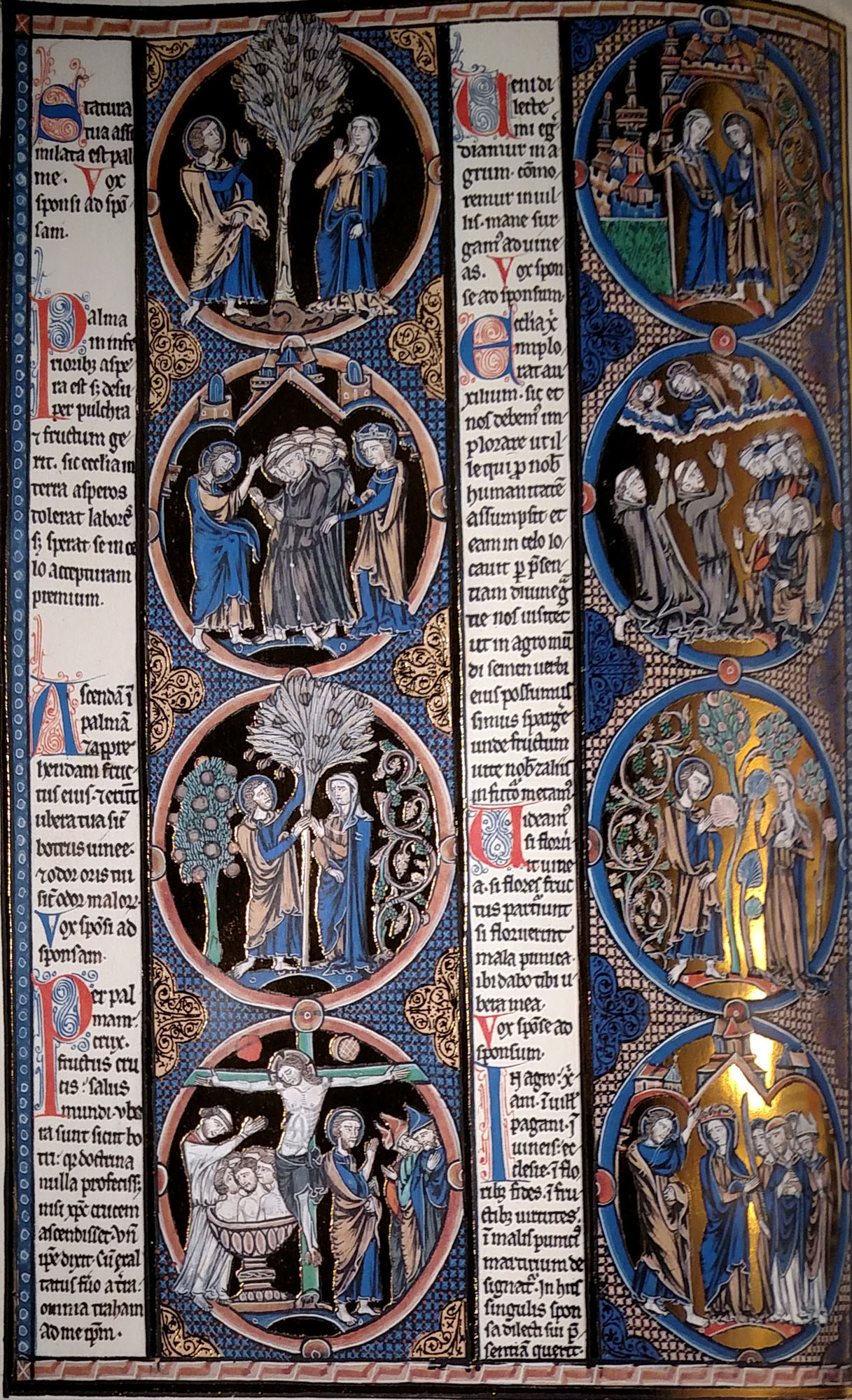A page from the Bible of St. Louis: Song of Solomon 7:7-12

1226-1234
Manuscript illuminations
Facsimile edition by M. Moleiro, Barcelona
Toledo Cathedral
This page exemplifies the medieval belief that the Song of Solomon is an allegory of Christ's love for the Church, here pictured as a crowned woman. The two columns alternate between presenting the text of the Song, along with an illustration of its literal meaning, with a paragraph of exegesis, accompanied by an illustration of the allegorical meaning.
Thus, at the top of the left column Statura tua assimilata est palme vox sponsi ad sponsam ("Thy stature is like to a palm tree, words of the bridegroom to the bride"), is next to a roundel with the bride and groom on either side of a palm tree that is in fruit. Then the next paragraph explains, "The lower parts of a palm tree are bitter, but up above it produces fruit. Thus the Church on earth endures bitter hardships but hopes for the reward it will receive in Heaven." In the accompanying illustration the Church presents to Christ men who have undergone the hard life of monks.
In the bottom of the left column "I will ascend into the palm tree, and will take hold of the fruit thereof: and thy breasts shall be as the clusters of the vine" (7:8a) is explained thus: "By the palm tree is meant the Cross. The fruit of the cross is the salvation of the world. 'Thy breasts are like grape clusters' whose preaching is useless without Christ's ascent onto the Cross. For he said, 'And I, if I be lifted up from the earth, will draw all things to myself' [John 12:32]." Correspondingly, the third roundel has the bridegroom about to lift himself up into the palm tree and the fourth has Christ on the cross. The blood from his side provides the water in which the priest on the left baptizes new Christians while the priest on the right, standing with his back to Christ, preaches unsuccessfully to an audience of doubtful Jews.
The text continues in the right column, explaining "Come, my beloved, let us go forth into the field, let us abide in the villages" (7:11-12a) with further allegory: "The Church is praying for Christ's help. In the same way we ought to pray that he who assumed humanity for us and took that humanity into Heaven will bless us with divine grace in the present so that in the future we may spread the seed of his word in the field of this world and reap for ourselves and others the fruit of life." This explanation and the earlier one about the uselessness of Christ-less preaching are clearly aimed at clerical evangelizers. The accompanying roundel shows two such men preaching to a crowd by lifting their arms and faces toward Christ in the heavens.
Finally, for the bride's "Let us get up early to the vineyards, let us see if the vineyard flourish, if the flowers be ready to bring forth fruits, if the pomegranates flourish: there will I give thee my breasts" the writer explains, "The field is the Christians, the villages are the pagans, the vineyards the Church, the flowers faith, their fruits the virtues. The pomegranates symbolize the martyrs whom the spouse wishes to present to her beloved." In the roundel the Church is doing just that, showing Christ a palm representing the martyrdom of the men on the right.
View this image in full resolution.
Read more about Ecclesia.
Photographed at the cathedral by Richard Stracke, shared under Attribution-NonCommercial-ShareAlike license.